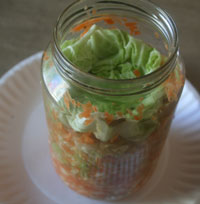Homemade Sauerkraut
Basic sauerkraut isn’t that hard. You just need sea salt, cabbage and some good glass or ceramic containers. And the patience to wait about two weeks.

This was my first kraut, which had chopped garlic and carrots in addition to the cabbage. Note the large cabbage leaf on top.
Ingredients and Supplies
- Cabbage – any kind will do
- Sea salt – a few sprinkles for every time you chop up some cabbage
- 1 large glass jar
- 1 small glass jar that will fit inside the large jar – I used a baby food jar.
- Knife, cutting board, large bowl
How to Prepare the Sauerkraut
Put aside one or two large, outer leaves from the cabbage for later. Chop the cabbage. When the cutting board is full of cabbage, put it in the large bowl and sprinkle on some sea salt. Each time you fill the cutting board with cabbage, sprinkle on some sea salt. If you prefer amounts, in his book Wild Fermentation, Sandor Katz suggests 3 tablespoons per 5 pounds of cabbage.
According to Sandor Katz, you can’t use table salt, as it may not work in the fermentation process. More about sea salt vs. table salt on this article. You can buy sea salt in Highland Park at Anna’s Health Food Center for about $3.
Once the chopped cabbage is in the bowl, you press it with your hands until the water from the cabbage starts to leak out. In one video I watched, the sauerkraut preparer used a potato masher to hasten the process. In another, the person wore plastic gloves while pressing the cabbage. Next, press the cabbage into the large glass jar. Take the outer leave(s) and press them on top of your chopped cabbage. If the brine doesn’t cover the chopped cabbage, add a little water + salt to the top so it does cover. Press your small baby food jar bottle on top of the cabbage. If you can’t cover your large jar with the cap (and you probably won’t be able to until the cabbage has settled more or has been eaten a bit), cover it with a cloth and a rubber band.
Place your jar on a high shelf in your kitchen or in your basement or some other cool, dry place. Do not refrigerate yet – that will stop the fermentation process. Feel free to try the mixture every few days. We ate some after one week, and then we ate the rest after two weeks. If you have the patience to wait a month, maybe it will be even better then!
Benefits of Fermentation
Sandor Katz writes: “Fermentation not only preserves nutrients, it breaks them down into more easily digestible forms.” Some of you may have heard of priobiotics and its many benefits — think of fermentation as creating your own probiotics. A Finnish study found fermented cabbage could be even healthier than raw or cooked cabbage for fighting cancer.
For more information:
- See the videos in this post on Fermentation Experimentation
- Read Sandor Katz’s book Wild Fermentation;
check out his recipe: Making Sauerkraut is Easy! - Healing Properties of Cabbage
- Plant-Derived Biomolecules in Fermented Cabbage

Ilana-Davita says
Did you use a sterilized glass jar?
Leora says
Sterilized? Why bother sterilizing? The idea is to get the good bacteria into the food.
Ilana-Davita says
The recipe I found the other day for pickled cucumbers recommends using a sterilized glass jar. That's why I was asking.
Leora says
Oh, okay. I just used a jar that I had cleaned in my dishwasher.
Rivka says
I have you bookmarked!I am going to try this ASAP.
I have also given this link to 4 of my friends.
Leora says
Great. I would love to get feedback on how it goes. There is no one way to do this - one can adapt to one's needs and preferences.
Rayna Eliana says
I will show this to my daughter and might try it. I like the photo...and the recipe sounds quite easy.
Donna says
I'm so very pleased to have found you. I've always loved sauerkraut but had only had store-bought until recently, when I bought a jar from a local farm. It was wonderful! No comparison to the stuff from the store, which I'll never be able to eat again, after tasting home made sauerkraut. Now, with your instructions, I can try making it myself. Thanks so much!
Leora says
Donna, sauerkraut is one of the easiest fermented foods to prepare. I love it. Good luck with working on making it.
Please leave a comment! I love to hear from you.